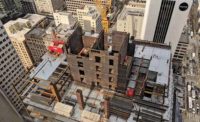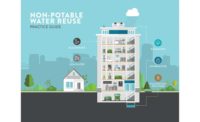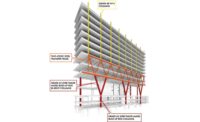The first U.S. design guide for steel castings—structural joints without welds or bolted plates—is likely to be published in about two years. And though there is support for specifications to expand the niche market for the specialized connections, stakeholders caution that there are challenges ahead.
“The guide would identify a portfolio of opportunities and list performance specifications that an engineer-of-record would include in a bid package” for a specialty casting designer or supplier, Raymond W. Monroe, executive vice president of the Steel Founders Society of America, noted at the North American Steel Construction Conference, held by the American Institute of Steel Construction on March 22-24 in San Antonio. SFSA is writing the guide with AISC’s assistance.
“The tool set would form the framework for the casting engineer-supplier to take full liability for performance” of the casting, added Monroe, one of nearly 4,600 attendees of the steel conference.
Made by casting liquid steel into shaped molds to make complex shapes, monolithic castings require sophisticated, finite-element stress analysis and knowledge of metallurgy and mechanics—disciplines not familiar to most structural engineers accustomed to fabricated steel.
Though there are castings in several hundred buildings in North America, they are used more typically in weapons systems, power generation, transportation systems and offshore platforms.
For buildings, high-strength-steel castings, such as nodes and clevises, often are used in exposed structures. They offer the designer geometric flexibility and simplify and speed field erection. Castings also provide more robust and resilient connections, thanks to the absence of welds and the ability to vary wall thickness, say engineers.
“We put the material where it wants to be for the flow of forces through the junctions,” said Carlos de Oliveira, president and CEO of CastConnex, the only company in North America that engineers, designs and supplies—it subcontracts the manufacturing to foundries—steel castings for building structures.
Castings may be simpler to erect, but they still have to be welded to the fabricated members of the main frame.
That presents a challenge. The American Welding Society’s structural welding code, AWS D 1.1, does not currently list any steel castings, said Duane K. Miller, manager of engineering services for welder Lincoln Electric Co.
Concerning welding, there are many variables, including the possibility the casting wall and its rolled structural element have different thicknesses and different chemistries. The welding issues make it more problematic to create a generic standard or specification, said Miller.
“Every fabricator that is going to weld structural steel to castings needs to develop a welding procedure specification” that is project-specific, added de Oliveira.
Some of the welding issues may be resolved soon. Work is underway to include additional information on the use of steel castings for building structures in the 2020 edition of D 1.1, said Miller.
AISC specifications include castings, but the properties are not well defined for structural shapes, he added. For example, steel with the same chemistry can result in a good or bad casting. The mold design is crucial. Also, the cavity needs to be filled properly to avoid voids and cold laps.
“With creative and responsible engineering, specifications can be put together,” said Miller, who supports the creation of a guide. But “an AISC spec can open the gate to irresponsible makers of poor castings,” he cautioned.
SFSA expects to begin work on the guide this fall, completing it in 2019. Funding is from a portion of a $10-million U.S. Dept. of Defense grant for general casting research and testing, called “Digital Innovative Design for Reliable Casting Performance.”
“The time is right for a design guide because architects are taking on more organic forms and castings have more complex geometries,” according to David E. Eckmann, a senior principal with structural engineer Magnusson Klemencic Associates. Eckmann was the catalyst for the guide.






Post a comment to this article
Report Abusive Comment